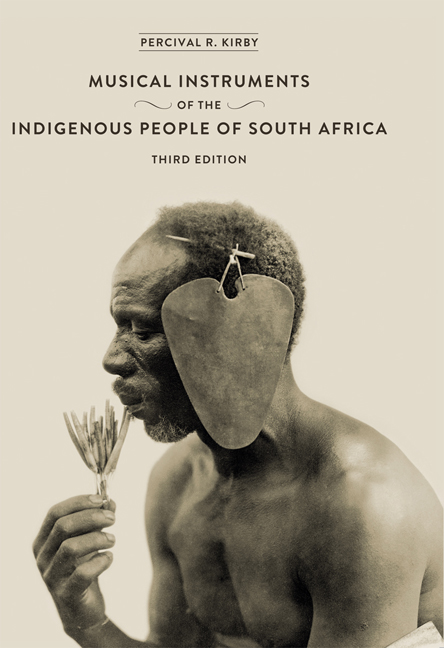Book contents
- Frontmatter
- Dedication
- Map
- Contents
- Foreword
- Preface to First Edition
- Preface to Second Edition
- Acknowledgements
- Acknowledgements to Third Edition
- List of Illustrations
- 1 Rattles and Clappers
- 2 Drums
- 3 Xylophones and ‘Sansas’
- 4 Bull-Roarers and Spinning-Disks
- 5 Horns and Trumpets
- 6 Whistles, Flutes, and Vibrating Reeds
- 7 Reed-Flute Ensembles
- 8 The ‘Gora’, A Stringed-Wind Instrument
- 9 Stringed Instruments
- 10 Bushman and Hottentot Violins and The ‘Ramkie’
- 11 Some European Instruments Played By Natives
- Appendix
- Addenda
- Index
- Frontmatter
- Dedication
- Map
- Contents
- Foreword
- Preface to First Edition
- Preface to Second Edition
- Acknowledgements
- Acknowledgements to Third Edition
- List of Illustrations
- 1 Rattles and Clappers
- 2 Drums
- 3 Xylophones and ‘Sansas’
- 4 Bull-Roarers and Spinning-Disks
- 5 Horns and Trumpets
- 6 Whistles, Flutes, and Vibrating Reeds
- 7 Reed-Flute Ensembles
- 8 The ‘Gora’, A Stringed-Wind Instrument
- 9 Stringed Instruments
- 10 Bushman and Hottentot Violins and The ‘Ramkie’
- 11 Some European Instruments Played By Natives
- Appendix
- Addenda
- Index
Summary
MUSICAL instruments made from the horns of animals and occasionally from other materials and sounded, as European ‘brass’ instruments are sounded, by causing the vibrating lips to make the air-column in the tube vibrate, are, or have been, common among the Bantu peoples of South Africa, but not among the Bushmen or Hottentots. With two exceptions, all these instruments are blown through an embouchure made in the side of the tube, not at the tip. Side-blown horns are characteristic of Africa, so it is not surprising to find that the two exceptional instruments, which will be considered later, have been adopted from other cultures. Apart from these, there are two main varieties of horns used by South African natives. The first are of large size, being made from the horns of the larger antelopes, or, when these have become scarce, from substitute materials, and the second of smaller size, being made from the horns of smaller antelopes, or from substitute materials.
The favourite horns used for the first type are those of the sable antelope (Hippotragus niger) and koodoo (Tragelaphus strepsiceros). The horn of the gemsbok (Oryx gazella) is less frequently used. In some areas, where game is no longer available, ox-horns are pressed into service. Such horns were observed in use among the Macaranga (Karanga) by the Portuguese priest Fr. João dos Santos,1 when he visited south-eastern Africa in 1586. In Book I, Chapter 10, of his Eastern Ethiopia, he wrote: ‘These Kaffirs have many other instruments which they call musical, but which I call ear-splitting. Such are the large horns of certain wild animals which they call paraparas, and therefore these horns are called parapandas, and they have a terrible and frightful sound like that of a bastard trumpet.’ The name, it will be seen, is, in spite of its spelling, the equivalent of mpalampala, or phalaphala, the name by which the instrument is generally known at the present time.
The phalaphala of the Venda is a typical example. The name of the instrument applies particularly to the sable antelope type, and it is also used for that instrument (allowing for linguistic variation) by the Chwana, Sotho, Swazi, Thonga, and, more rarely, by the Zulu. Among the Venda the phalaphala is a very important instrument, being put to all kinds of ceremonial uses.
- Type
- Chapter
- Information
- The Musical Instruments of the Indigenous People of South Africa , pp. 104 - 125Publisher: Wits University PressPrint publication year: 2013



